
Molecular Fluorescence
.pdf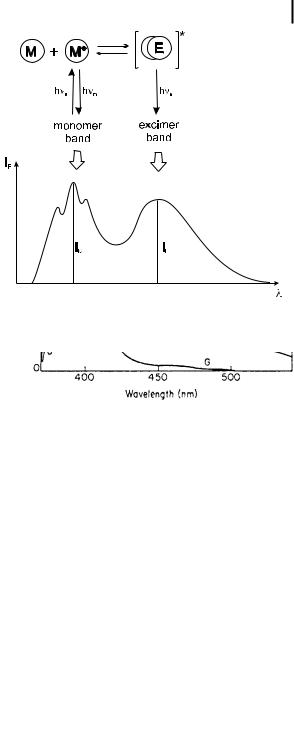
4.4 Formation of excimers and exciplexes 95
Fig. 4.6. Excimer formation, with the corresponding monomer and excimer bands.
Fig. 4.7. Fluorescence spectra of pyrene at various concentrations in cyclohexane. A: 10 2 mol L 1; B: 7:75 10 3
mol L 1; C: 5:5 10 3 mol L 1; D: 3:25 10 3 mol L 1; E: 10 3 mol L 1; G: 10 4 mol L 1 (from Birks and Christophorou, (1963) Spectrochim. Acta, 19, 401).
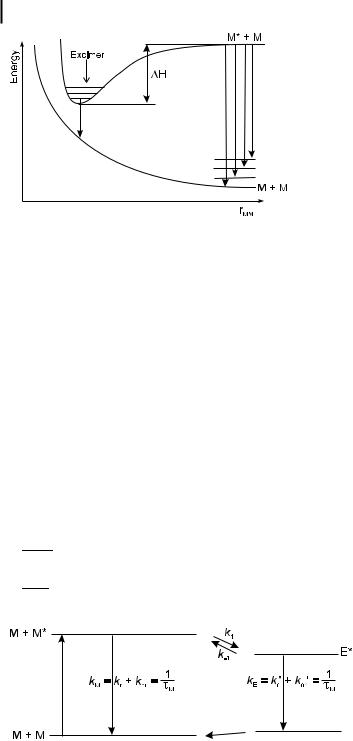
96 4 Effects of intermolecular photophysical processes on fluorescence emission
Scheme 4.4
These features can be explained on the basis of energy surfaces, as shown in Scheme 4.4. The lower monotonous curve represents the repulsive energy between the two molecules in the ground state. The upper curve, which is relative to two molecules (one of them being in the ground state), exhibits a minimum corresponding to the formation of an excimer in which the two aromatic rings are facing at a distance of @3–4 A˚ . For example, this distance is 3.37 A˚ for pyrene and the experimental value of the stabilization energy DH of the excimer is 170 kJ mol 1. In contrast to the monomer band, the excimer band is structureless because the lowest state is dissociative and can thus be considered as a continuum.
The time evolution of the fluorescence intensity of the monomer M and the excimer E following a d-pulse excitation can be obtained from the di erential equations expressing the evolution of the species. These equations are written according to the kinetic in Scheme 4.5 where kM and kE are reciprocals of the excited-state lifetimes of the monomer and the excimer, respectively, and k1 and k 1 are the rate constants for the excimer formation and dissociation processes, respectively. Note that this scheme is equivalent to Scheme 4.3 where (MQ) ¼ (MM) ¼ E and in which the formation of products is ignored.
According to Scheme 4.5, the coupled di erential equations can be written as
d½M & ¼ kM½M & k1½M&½M & þ dt
d½E & ¼ k1½M&½M & ðkD þ k 1Þ½E dt
k 1½E &
&
ð4:41Þ
ð4:42Þ
Scheme 4.5

4.4 Formation of excimers and exciplexes 97
Because formation of excimer E is a di usion-controlled process, Eqs (4.11)–(4.13) apply to the di usional rate constant k1 for excimer formation. Under the approximation that k1 is time-independent, the d-pulse responses, under the initial conditions (at t ¼ 0), [M ] ¼ [M ]0 and [E ]0 ¼ 0, are
i |
t |
k |
|
M |
|
kr½M &0 |
X |
|
b |
|
|
e b1t |
|
b |
|
|
X e b2t |
|
|
4:43 |
|||||
r½ |
& ¼ b1 b2 ½ð |
|
|
Þ |
þ ð |
|
|
& |
ð |
||||||||||||||||
|
Mð Þ ¼ |
|
|
|
|
|
|
2 |
|
|
|
|
1 |
Þ |
Þ |
||||||||||
i |
t |
k0k |
|
E |
& ¼ |
kr0k1½M&½M &0 |
½ |
e b2t |
|
e b1t |
& |
|
|
|
ð |
4:44 |
|||||||||
|
Eð Þ ¼ |
r 1½ |
|
|
b1 b2 |
|
|
|
|
|
|
|
|
|
|
Þ |
|||||||||
where and b2
b2; 1
kr and kr0 are the radiative rate constants of M and E , respectively, and b1 are given by
¼ |
1 |
½M&&1=2g |
ð4:45Þ |
2 fX þ Y G½ðY XÞ2 þ 4k1k 1 |
where X ¼ kM þ k1½M& ¼ 1=tM þ k1½M& and Y ¼ kE þ k 1 ¼ 1=tE þ k 1.
The decay of monomer emission is thus a sum of two exponentials. In contrast, the time evolution of the excimer emission is a di erence of two exponentials, the pre-exponential factors being of opposite signs. The time constants are the same in the expressions of iMðtÞ and iEðtÞ (b1 and b2 are the eigenvalues of the system). The negative term in iEðtÞ represents the increase in intensity corresponding to excimer formation; the fluorescence intensity indeed starts from zero because excimers do not absorb light and can only be formed from the monomer (Figure 4.8A).
If the dissociation of the excimer cannot occur during the lifetime of the excited
state ðk 1 fkEÞ, we have |
|
|
|
|
|
|||
|
|
|
|
|
|
|
|
|
|
iMðtÞ ¼ kr½M &0e Xt |
|
|
|
|
|
ð4:46Þ |
|
|
i t |
kr0k1½M&½M &0 |
½ |
e kEt |
|
e Xt |
& |
4:47 |
|
X kE |
|||||||
|
Eð Þ ¼ |
|
|
ð Þ |
||||
In this case, the fluorescence decay of the monomer is a single exponential (Figure 4.8B). The relevant decay time ð1=XÞ is equal to the rise time of the excimer fluorescence6).
The steady-state fluorescence intensities are obtained by integration of Eqs (4.43) and (4.44). The ratio of the fluorescence intensities of the excimer and monomer bands, IE=IM (Figure 4.6), is often used to characterize the e ciency of excimer formation. This ratio is given by
6)It should be noted that at high temperatures, a dynamic equilibrium can rapidly be reached in the excited state. The condition k1½M&,
k 1 gkM, kE can be satisfied above a critical temperature. Then, the fluorescence of
monomer and excimer each decay exponentially with a common decay time constant that is an average of the intrinsic lifetimes of the monomer and the excimer (Birks, 1969).
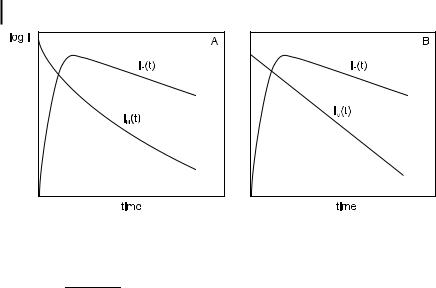
98 4 Effects of intermolecular photophysical processes on fluorescence emission
Fig. 4.8. Fluorescence decays of the monomer and the excimer. (a) Dissociation of the excimer within excited-state lifetime. (b) No dissociation of the excimer.
I |
E |
|
k0 |
k |
1 |
|
M |
|
|
|
|
|
r |
|
½ |
& |
|
4:48 |
|||
IM |
¼ kr k 1 þ 1=tE |
ð |
||||||||
Þ |
||||||||||
Under conditions in which the dissociation rate of the excimer is slow with respect to de-excitation, Eq. (4.48) is reduced to
IE |
|
kr0 |
|
|
|
¼ |
|
tEk1½M& |
ð4:49Þ |
IM |
kr |
|||
These equations show that the ratio IE=IM is proportional to the rate constant k1 for excimer formation. Assuming that the Stokes–Einstein relation (Eq. 4.12) is valid, k1 is proportional to the ratio T=h, h being the viscosity of the medium. Application to the estimation of the fluidity of a medium will be discussed in Chapter 8.
When the two monomers are linked by a short flexible chain, intramolecular excimers can be formed. This process is still di usion-controlled, but in contrast to the preceding case, it is not translational; it requires a close approach between the two molecules via internal rotations during the excited-state lifetime. Equations (4.44), (4.45), (4.47) to (4.49) are still valid after replacing k1½M& by k1 because intramolecular excimer formation is independent of the total concentration. Estimation of the local fluidity of a medium can be achieved by means of probes capable of forming intramolecular excimers (see Chapter 8).
In some cases, a monomer in the ground state may already be close to another monomer (e.g. in polymers with pendant fluorophores or on solid surfaces with adsorbed or covalently linked fluorophores), so that the displacement and the rotation required to attain the favorable excimer conformation occurs very quickly. These excimers are called ‘excimer-like’ or ‘preformed excimers’, in contrast to the normal case of ‘true excimers’. The rise time corresponding to excimer formation may not be detected with instruments whose time resolution is of a few picoseconds.
A popular method for the determination of micellar aggregation numbers is based on self-quenching of pyrene by excimer formation within micelles (see Box 4.2).
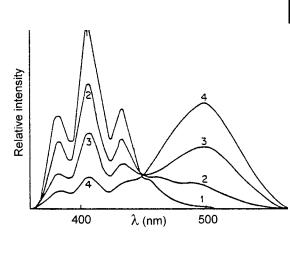
4.5 Photoinduced proton transfer 99
Fig. 4.9. Fluorescence spectra of anthracene (3 10 4
mol L 1) in the presence of diethylaniline at various concentrations in toluene. 1: 0 mol L 1; 2: 5 10 3 mol L 1; 3: 2:5 10 2 mol L 1; 4: 0.10 mol L 1 (from Weller, A. (1967), in Claesson S. (Ed.), Fast Reactions and Primary Processes in Chemical Kinetics, John Wiley & Sons, New York).
4.4.2
Exciplexes
A well-known example of an exciplex is the excited-state complex of anthracene and N,N-diethylaniline resulting from the transfer of an electron from an amine molecule to an excited anthracene molecule. In nonpolar solvents such as hexane, the quenching is accompanied by the appearance of a broad structureless emission band of the exciplex at higher wavelengths than anthracene (Figure 4.9). The kinetic scheme is somewhat similar to that of excimer formation.
When the solvent polarity increases, the exciplex band is red-shifted. The intensity of this band decreases as a result of the competition between de-excitation and dissociation of the exciplex.
It should be noted that de-excitation of exciplexes can lead not only to fluorescence emission but also to ion pairs and subsequently ‘free’ solvated ions. The latter process is favored in polar media. Exciplexes can be considered in some cases to be intermediate species in electron transfer from a donor to an acceptor (see Section 4.3).
4.5
Photoinduced proton transfer
This section will only cover reactions in aqueous solutions. Water molecules acting as either a proton acceptor or a proton donor will thus be in close contact with an acid or a base undergoing excited-state deprotonation or protonation, respectively. Therefore, these processes will not be di usion-controlled (Case A in Section 4.2.1).
The acidic or basic properties of a molecule that absorbs light are not the same in the ground state and in the excited state. The redistribution of the electronic density upon excitation may be one of the possible causes of this observation. The most interesting cases are those where acids and bases are stronger in the excited state

100 4 Effects of intermolecular photophysical processes on fluorescence emission
than in the ground state, because in these cases, excitation may trigger a photoinduced proton transfer. Then, the acidic character of a proton donor group (e.g. OH substituent of an aromatic ring) can be enhanced upon excitation so that the pK of this group in the excited state is much lower than the pK in the ground state (Table 4.4). In the same way, the pK of a proton acceptor group (e.g. heterocyclic nitrogen atom) in the excited state is much higher than in the ground state (pK) (Table 4.4).
The occurrence of excited-state proton transfer during the lifetime of the excited state depends on the relative rates of de-excitation and proton transfer. The general equations will be presented first, but only for the most extensively studied case where the excited-state process is proton ejection (pK < pK); the proton donor is thus an acid, AH , and the proton acceptor is a water molecule. Methods for the determination of pK are then described and finally, the various cases of pH dependence of the absorption and fluorescence spectra are examined.
4.5.1
General equations
Let us consider the possible events following excitation of an acid AH that is stronger in the excited state than in the ground state (pK < pK). In the simplest case, where there is no geminate proton recombination, the processes are presented in Scheme 4.6, where t0 and t00 are the excited-state lifetimes of the acidic (AH ) and basic (A ) forms, respectively, and k1 and k 1 are the rate constants for deprotonation and reprotonation, respectively. k1 is a pseudo-first order rate constant, whereas k 1 is a second-order rate constant. The excited-state equilibrium constant is K ¼ k1=k 1.7)
The question arises as to whether or not the back-reaction can take place during the excited-state lifetime of A . Because this reaction is di usion-controlled (k 1 A5 1010 L mol 1 s 1), its rate is pH-dependent. If pH a2, the back-reaction must be taken into account because at this pH, k 1½H3Oþ& 95 108 s 1. The reciprocal of this value is indeed of the order of the excited-state lifetime of most organic bases.
The time evolution of the fluorescence intensity of the acidic form AH and the basic form A following d-pulse excitation can be obtained from the di erential equations expressing the evolution of the species. These equations are written
according to Scheme 4.6: |
|
|
|
|
|
|
|
|
|
|
|
|
|
|
|
|
|||||||||
|
d½AH & |
|
|
k |
|
1=t |
0Þ½ |
AH |
& þ |
k |
|
½ |
A |
&½ |
H Oþ |
& |
ð |
4:50 |
|||||||
|
dt |
|
¼ ð 1 þ |
|
|
|
1 |
|
|
3 |
|
Þ |
|||||||||||||
|
d½A & |
|
k |
1½ |
AH |
|
k |
|
H Oþ |
& þ |
1=t0 |
Þ½ |
A |
& |
|
ð |
4:51 |
||||||||
|
dt |
|
|
|
|
||||||||||||||||||||
|
¼ |
|
& ð |
|
1½ |
3 |
|
|
|
0 |
|
|
|
Þ |
|||||||||||
7)k1 and k 1 are normalized so that K is dimensionless.
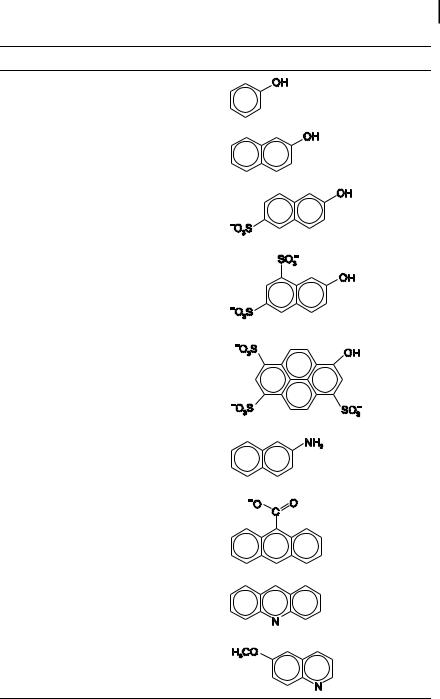
|
|
|
|
|
|
|
|
|
|
|
4.5 |
Photoinduced proton transfer 101 |
|
Tab. 4.4 |
|
|
|
|
|
|
|
|
|
|
|
|
|
|
> |
|
|
|
|
|
|
|
> |
COMPOUND |
FORMULA |
pK |
pK |
|
|
|
|
|
|
|
|
|
|
|
|
||
|
> |
|
|
|
|
|
|
|
> |
|
|
|
|
|
> |
|
|
|
|
|
|
|
> |
phenol |
|
10.6 |
3.6 |
|
> |
|
|
|
|
|
|
|
> |
|
|||
|
8 |
|
|
|
|
|
|
|
8 |
|
|||
|
> |
|
|
|
|
|
|
|
> |
|
|
|
|
|
> |
|
|
|
|
|
|
|
> |
|
|
|
|
|
> |
|
|
|
|
|
|
|
> |
|
|
|
|
|
> |
|
|
|
|
|
|
|
> |
|
|
|
|
|
> |
|
|
|
|
|
|
|
> |
|
|
|
|
|
> |
|
|
|
|
|
|
|
> |
|
|
|
|
|
> |
|
|
|
|
|
|
|
> |
|
|
|
|
|
> |
|
|
|
|
|
|
|
> |
|
|
|
|
|
> |
|
|
|
|
|
|
|
> |
|
|
|
|
|
> |
|
|
|
|
|
|
|
> |
|
|
|
|
|
> |
|
|
|
|
|
|
|
> |
|
|
|
|
DEPROTONATION |
> |
|
|
|
|
|
|
|
> |
|
|
|
|
> |
|
|
|
|
|
|
|
> |
|
|
|
|
|
> |
|
|
|
|
|
|
|
> |
sulfonate |
|
|
|
|
> |
|
|
|
|
|
|
|
> |
|
|
|
||
|
> |
|
|
|
|
|
|
|
> |
2-naphthol |
|
9.3 |
2.8 |
|
> |
|
|
|
|
|
|
|
> |
|
|||
|
> |
|
|
|
|
|
|
|
> |
|
|||
|
> |
|
|
|
|
|
|
|
> |
|
|||
|
> |
|
|
|
|
|
|
|
> |
|
|
|
|
|
> |
|
|
|
|
|
|
|
> |
|
|
|
|
|
> |
|
|
|
|
|
|
|
> |
|
|
|
|
|
> |
|
|
|
|
|
|
|
> |
|
|
|
|
|
> |
|
|
|
|
|
|
|
> |
|
|
|
|
|
> |
|
|
|
|
|
|
|
> |
|
|
|
|
|
> |
|
|
|
|
|
|
|
> |
|
|
|
|
|
> |
|
|
|
|
|
|
|
> |
|
|
|
|
|
> |
|
|
|
|
|
|
|
> |
|
|
|
|
|
> |
|
|
|
|
|
|
|
> |
|
|
|
|
|
> |
|
|
|
|
|
|
|
> |
|
|
|
|
|
> |
|
|
|
|
|
|
|
> |
|
|
|
|
|
> |
|
|
|
|
|
|
|
> |
|
|
|
|
|
> |
|
|
|
|
|
|
|
> |
|
|
|
|
|
> |
|
|
|
|
|
|
|
> |
|
|
|
|
|
> |
|
|
|
|
|
|
|
> |
2-naphthol-6- |
|
9.12 |
1.66 |
|
> |
|
|
|
|
|
|
|
> |
|
|||
|
> |
|
|
|
|
|
|
|
> |
|
|||
|
> |
|
|
|
|
|
|
|
> |
|
|
|
|
|
> |
|
|
|
H |
|
|
> |
|
|
|
|
|
|
> |
|
|
|
|
|
þ |
|
> |
|
|
|
|
|
> |
|
|
|
|
|
|
> |
|
|
|
|
|
STATE |
> |
|
|
|
|
|
|
|
> |
|
|
|
|
> |
|
|
|
|
|
|
|
> |
|
|
|
|
|
> |
|
|
|
! |
|
< |
|
|
|
|
|||
> |
|
|
|
|
> |
|
|
|
|
||||
|
> |
|
|
|
|
|
|
ArO > |
|
|
|
|
|
|
> |
|
|
|
|
|
|
|
|
|
|
||
|
> |
|
|
|
|
|
|
|
|
|
|
||
|
> |
|
|
|
|
|
|
|
|
||||
|
> |
|
|
|
|
|
|
|
|||||
|
> ArOH |
|
|
|
|
|
|
|
|
|
|||
|
> |
|
|
|
|
|
|
|
> |
|
|
|
|
EXCITED- |
> |
|
|
|
|
|
|
|
> |
|
|
|
|
< |
|
|
|
|
|
|
|
> |
|
|
|
|
|
|
|
|
|
|
|
|
|
> |
|
|
|
|
|
|
|
|
|
|
|
|
|
> |
|
|
|
|
|
|
|
|
|
|
|
|
|
|
> |
|
|
|
|
|
> |
|
|
|
|
|
|
|
> |
2-naphthol-6,8- |
|
9.3 |
<1 |
|
|
|
|
|
|
|
|
> |
|
||||
|
> |
|
|
|
|
|
|
|
> |
|
|||
|
> |
|
|
|
|
|
|
|
> |
|
|
|
|
|
> |
|
|
|
|
|
|
|
> |
|
|
|
|
|
> |
|
|
|
|
|
|
|
> |
disulfonate |
|
|
|
|
> |
|
|
|
|
|
|
|
> |
|
|
|
|
|
> |
|
|
|
|
|
|
|
> |
|
|
|
|
|
> |
|
|
|
|
|
|
|
> |
|
|
|
|
|
|
|
|
|
|
|
|
> |
|
|
|
|
|
|
> |
|
|
|
|
|
|
|
> |
|
|
|
|
|
> |
|
|
|
|
|
|
|
> |
|
|
|
|
|
> |
|
|
|
|
|
|
|
> |
|
|
|
|
|
> |
|
|
|
|
|
|
|
> |
|
|
|
|
|
> |
|
|
|
|
|
|
|
> |
|
|
|
|
|
> |
|
|
|
|
|
|
|
> |
|
|
|
|
|
> |
|
|
|
|
|
|
|
> |
|
|
|
|
|
> |
|
|
|
|
|
|
|
> |
|
|
|
|
|
> |
|
|
|
|
|
|
|
> |
|
|
|
|
|
> |
|
|
|
|
|
|
|
> |
|
|
|
|
|
> |
|
|
|
|
|
|
|
> |
|
|
|
|
|
> |
|
|
|
|
|
|
|
> |
|
|
|
|
|
> |
|
|
|
|
|
|
|
> |
|
|
|
|
|
> |
|
|
|
|
|
|
|
> |
|
|
|
|
|
> |
|
|
|
|
|
|
|
> |
|
|
|
|
|
> |
|
|
|
|
|
|
|
> |
|
|
|
|
|
> |
|
|
|
|
|
|
|
> |
|
|
|
|
|
> |
|
|
|
|
|
|
|
> |
|
|
|
|
|
> |
|
|
|
|
|
|
|
> |
|
|
|
|
|
> |
|
|
|
|
|
|
|
> |
|
|
|
|
|
> |
|
|
|
|
|
|
|
> |
8-hydroxypyrene- |
|
7.7 |
1.3 |
|
> |
|
|
|
|
|
|
|
> |
|
|||
|
> |
|
|
|
|
|
|
|
> |
|
|||
|
> |
|
|
|
|
|
|
|
> |
|
|
|
|
|
> |
|
|
|
|
|
|
|
> |
1,3,6-trisulfonate |
|
|
|
|
> |
|
|
|
|
|
|
|
> |
|
|
|
|
|
> |
|
|
|
|
|
|
|
> |
|
|
|
|
|
> |
|
|
|
|
|
|
|
> |
|
|
|
|
|
> |
|
|
|
|
|
|
|
> |
|
|
|
|
|
> |
|
|
|
|
|
|
|
> |
|
|
|
|
|
> |
|
|
|
|
|
|
|
> |
(pyranine) |
|
|
|
|
> |
|
|
|
|
|
|
|
> |
|
|
|
|
|
> |
|
|
|
|
|
|
|
> |
|
|
|
|
|
> |
|
|
|
|
|
|
|
: |
|
|
|
|
|
> |
|
|
|
|
|
|
|
|
|
|
|
|
|
> |
|
|
|
|
|
|
|
|
|
|
|
|
|
> |
|
|
|
|
|
|
|
|
|
|
|
|
|
> |
|
|
|
|
|
|
|
|
|
|
|
|
|
> |
|
|
|
Hþ |
|
|
|
|
|
|
||
|
> |
|
|
|
|
|
|
|
|
|
|
||
|
> |
|
|
|
|
|
|
|
|
|
|
|
|
|
> |
|
|
|
|
|
! |
|
|
|
|
|
|
|
> |
|
|
|
|
|
|
|
|
|
|
||
|
> |
|
|
|
|
|
|
|
|
|
|
|
|
|
> |
|
|
|
|
|
|
|
|
|
|
|
|
|
> |
|
|
|
|
|
|
|
ArNH |
|
|
|
|
|
> |
|
|
|
|
|
|
|
2-naphthylamine |
|
7.1 |
12.2 |
|
|
> |
|
|
|
|
|
|||||||
|
> |
|
|
|
|
||||||||
|
> ArNH2 |
|
|
|
|
|
|
||||||
|
> |
|
|
|
|
|
|
|
|
|
|
|
|
|
: |
|
|
|
|
|
|
|
|
|
|
|
|
PROTONATION |
8 |
|
|
|
|
|
|
|
|
|
|
|
|
> |
2 |
|
|
|
|
|
|
|
|
|
|
|
|
> |
|
|
|
|
|
|
|
|
|
|
|
|
|
|
> |
|
|
|
|
|
! |
|
|
|
|
|
|
|
> |
|
|
|
|
|
|
|
|
|
|
||
|
> |
|
|
|
|
|
|
|
|
|
|
|
|
|
> |
|
|
|
|
|
|
|
|
|
|
|
|
|
> |
|
|
|
|
|
|
|
ArCO2H |
anthracene-9- |
|
3.7 |
6.9 |
|
> |
|
|
|
|
|
|||||||
|
> |
|
|
|
|
||||||||
|
> ArCO þHþ |
|
|
||||||||||
|
> |
|
|
|
|
|
|
|
|
|
|
|
|
|
> |
|
|
|
|
|
|
|
|
carboxylate |
|
|
|
|
> |
|
|
|
|
|
|
|
|
|
|
|
|
|
> |
|
|
|
|
|
|
|
|
|
|
|
|
|
> |
|
|
|
|
|
|
|
|
|
|
|
|
|
> |
|
|
|
|
|
|
|
|
|
|
|
|
|
> |
|
|
|
|
|
|
|
|
|
|
|
|
|
> |
|
|
|
|
|
|
|
|
|
|
|
|
|
> |
|
|
|
|
|
|
|
|
|
|
|
|
|
> |
|
|
|
|
|
|
|
|
|
|
|
|
|
> |
|
|
|
|
|
|
|
|
|
|
|
|
|
> |
|
|
|
|
|
|
|
|
|
|
|
|
|
> |
|
|
|
|
|
|
|
8 |
|
|
|
|
|
> |
|
|
|
|
|
|
|
|
|
|
|
|
STATE- |
< |
|
|
|
|
|
|
|
> |
|
|
|
|
|
|
|
|
|
|
|
|
> |
|
|
|
|
|
|
|
|
|
|
|
|
|
> |
|
|
|
|
|
|
|
|
|
|
|
|
|
|
> |
|
|
|
|
|
|
|
Hþ |
|
|
|
> |
|
|
|
|
||
|
> |
|
|
|
|
> |
acridine |
|
5.5 |
10.6 |
|||
|
|
|
|
|
|
|
|
> |
|
||||
|
> |
|
|
|
|
|
|
|
> |
|
|||
|
> |
|
|
|
|
|
|
|
|
|
|
|
|
|
> |
|
! |
|
|
|
> |
|
|
|
|
||
|
> |
|
|
|
|
> |
|
|
|
|
|||
|
> |
|
|
|
|
|
|
|
> |
|
|
|
|
|
> |
|
|
|
|
|
|
|
< |
|
|
|
|
EXCITED |
> |
|
|
|
|
|
ArNHþ > |
|
|
|
|
||
> |
|
|
|
|
|
|
|
|
|
||||
> |
|
|
|
|
|
|
|
|
|
||||
|
> |
|
|
|
|
|
|
|
|
||||
|
> |
|
|
|
|
|
|
|
|||||
|
> ArN |
þ |
|
|
|
|
|
|
|
|
|||
|
> |
|
|
|
|
|
|
|
> |
|
|
|
|
|
> |
|
|
|
|
|
|
|
|
|
|
|
|
|
> |
|
|
|
|
|
|
|
> |
|
|
|
|
|
> |
|
|
|
|
|
|
|
> |
|
|
|
|
|
> |
|
|
|
|
|
|
|
> |
|
|
|
|
|
> |
|
|
|
|
|
|
|
> |
|
|
|
|
|
> |
|
|
|
|
|
|
|
> |
|
|
|
|
|
> |
|
|
|
|
|
|
|
> |
|
|
|
|
|
> |
|
|
|
|
|
|
|
> |
6-methoxyquinoline |
|
5.2 |
11.8 |
|
> |
|
|
|
|
|
|
|
> |
|
|||
|
> |
|
|
|
|
|
|
|
> |
|
|||
|
> |
|
|
|
|
|
|
|
> |
|
|
|
|
|
> |
|
|
|
|
|
|
|
> |
|
|
|
|
|
: |
|
|
|
|
|
|
|
: |
|
|
|
|
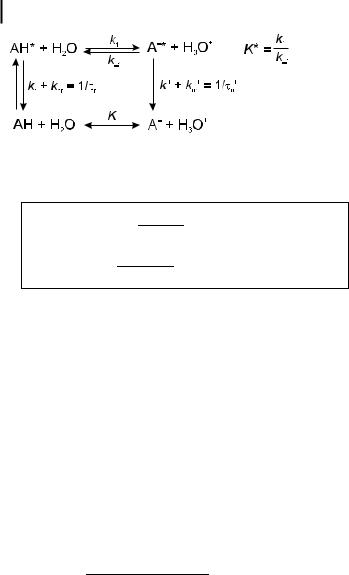
102 4 Effects of intermolecular photophysical processes on fluorescence emission
Scheme 4.6
When AH is selectively excited, the d-pulse tensities, under the initial conditions [AH ] ¼
responses of the fluorescence in- [AH ]0 and ½A &0 ¼ 0 (at t ¼ 0), are
iAH ðtÞ ¼ kr½AH & ¼ kr½AH &0 ½ðX b2Þe b1t þ ðb1 XÞe b2t& b1 b2
iA ¼ kr0½A & ¼ kr0k1½AH &0 ½e b2t e b1t& b1 b2
ð4:52Þ
ð4:53Þ
where kr and kr0 are the radiative rate constants of AH and A , respectively, and b1 and b2 are given by
b |
|
¼ |
1 |
X |
Y |
G½ð |
Y |
|
X |
Þ |
2 |
þ |
4k k |
½ |
H |
Oþ |
&& |
1=2 |
g |
ð |
4:54 |
|
|
|
|
||||||||||||||||||
|
2; 1 |
2 f þ |
|
|
|
|
1 1 |
3 |
|
|
Þ |
||||||||||
where X ¼ k1 þ 1=t0 and Y ¼ k 1½H3Oþ& þ 1=t00 .
Under continuous illumination, the steady-state intensities can be easily calculated by considering a light of constant intensity as an infinite sum of infinitely short light pulses. The steady-state intensities are thus simply obtained by integration of Eqs (4.52) and (4.53).
In practice, a multiplication factor C must be introduced to take into account the experimental conditions (total concentration, choice of excitation and emission wavelengths, bandpasses for absorption and emission intensity of the incident light, sensitivity of the instrument).
IAH |
¼ |
CF0 |
|
|
1 þ k 1t00 ½H3Oþ& |
|
|
ð |
4:55 |
|||||||
|
|
|
|
1 þ k1t0 þ k 1t00 ½H3Oþ& |
Þ |
|||||||||||
I |
|
¼ |
CF0 |
|
|
|
|
|
k1t0 |
|
|
|
|
|
ð |
4:56 |
|
A |
0 1 |
þ |
k t |
0 |
k |
t0 |
H |
Oþ |
& |
|
Þ |
||||
|
|
|
|
|
|
1 |
þ 1 |
0½ |
3 |
|
|
|
|
|||
where F0 and F00 are the fluorescence quantum yields of AH and A , respectively, in the absence of the excited-state reaction (F0 ¼ kr t0; F00 ¼ kr0t00 ).
Under pH conditions where the back reaction is too slow to take place during the excited-state lifetime ðk 1½H3Oþ& f1=t00 Þ, the kinetic scheme is simplified and leads to the following equations:
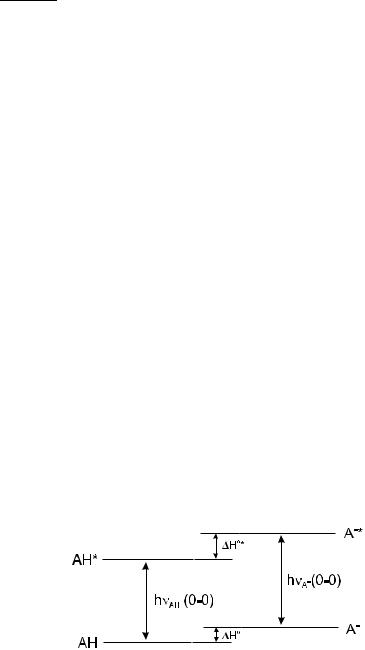
|
|
|
|
|
|
|
|
|
4.5 |
Photoinduced proton transfer |
103 |
|
|
|
|
|
|
|
|
||||||
|
|
|
|
|
|
|
|
|
|
|
|
|
iAH ðtÞ ¼ ½AH &0kre Xt |
|
|
|
|
ð4:57Þ |
|
||||||
iA |
t |
kr0k1½AH &0 |
½ |
e Yt |
|
e Xt |
& |
|
4:58 |
|
||
|
ð Þ ¼ |
X |
|
Y |
|
|
|
ð Þ |
|
|||
|
|
|
|
|
|
|
|
|
|
|
|
|
where X ¼ k1 þ 1=t0 and Y ¼ 1=t00 . Therefore, iAH ðtÞ becomes a single exponential and iA ðtÞ is still a di erence of two exponentials with a rise time ð1=XÞ (equal to the decay time of AH ), and a decay time ð1=YÞ (equal to the lifetime of the basic form).
The steady-state intensities reduce to
IHA ¼ CF0 |
1 |
|
ð4:59Þ |
|||
|
|
|||||
1 þ k1t0 |
||||||
I |
A ¼ |
CF0 |
|
k1t0 |
4:60 |
|
|
|
|
||||
|
0 1 þ k1t0 |
ð Þ |
||||
4.5.2
Determination of the excited-state pK
4.5.2.1 Prediction by means of the Fo¨rster cycle
pK can be theoretically predicted by means of the Fo¨rster cycle (Scheme 4.7) in conjunction with spectroscopic measurements.
According to this cycle, we have
NahnAH þ DH0 ¼ NahnA þ DH0 |
ð4:61Þ |
where DH0 and DH0 are the standard molar ionization enthalpies of AH and AH , respectively, hnAH and hnA are the energy di erences (corresponding to the 0–0 transitions) between the excited state and the ground state of AH and A , respectively, and Na is Avogadro’s number. This equation can be rewritten as
Scheme 4.7

104 |
4 Effects of intermolecular photophysical processes on fluorescence emission |
|
|
DH0 DH0 ¼ NaðhnA hnAHÞ |
ð4:62Þ |
Assuming that the ionization entropies DS0 and DS0 of AH and AH 8), respec-
tively, are equal, the di erence in enthalpies DH0 DH0 |
can be replaced by the |
di erence in standard free energies DG0 DG0, each of them being given by |
|
DG0 ¼ RT ln K ¼ 2:3RT pK |
ð4:63Þ |
and |
|
DG0 ¼ RT ln K ¼ 2:3RT pK |
ð4:64Þ |
where R is the gas constant and T is the absolute temperature. Using Eqs (4.63) and (4.64), and converting the frequencies into wavenumbers (in cm 1), Eq. (4.62) becomes (at 298 K)
pK pK ¼ 2:1 10 3ð |
|
A |
|
AHÞ |
ð4:65Þ |
n |
n |
This equation shows that if the emission band of the basic form is located at higher wavelengths than that of the acidic form, the excited-state pK is lower than the ground-state pK, and AH is a stronger acid than AH. Conversely, if the emission band of the basic form is blue-shifted with respect to the emission band of the acidic form, the acid in the excited state is weaker than in the ground state.
In practice, the wavenumbers nAH and nA corresponding to the 0–0 transitions of AH and A are often di cult to determine accurately. They are usually estimated by means of the average between the wavenumbers corresponding to the maxima of absorption and emission:
nmax þ nmax
n00 ¼ abs em ð4:66Þ
2
However, the best approximation is found by using the intersection point of the mutually normalized absorption and emission spectra (as was the practice in Fo¨rster’s laboratory). In the case of large Stokes shift, it may be di cult to determine an intersection point; it is then preferable to take the average of the wavenumbers corresponding to half-heights of the absorption and emission bands, which is a better approximation than the average of the wavenumbers corresponding to the maxima.
8)The approximation DS ADS is reasonable in most cases because the major contribution to entropy variation is the change in the number of molecules and in the number of charges (and of the corresponding solvation). Both these contributions are the same in the ground and excited states. The changes in the internal degrees of freedom can be shown to
be negligible. With respect to changes in dipole moments upon excitation and the consequent solvation e ects, they are often similar for the acidic and the basic forms. However, there are noticeable exceptions (e.g. aromatic amines and their conjugates, arylammonium ions).
